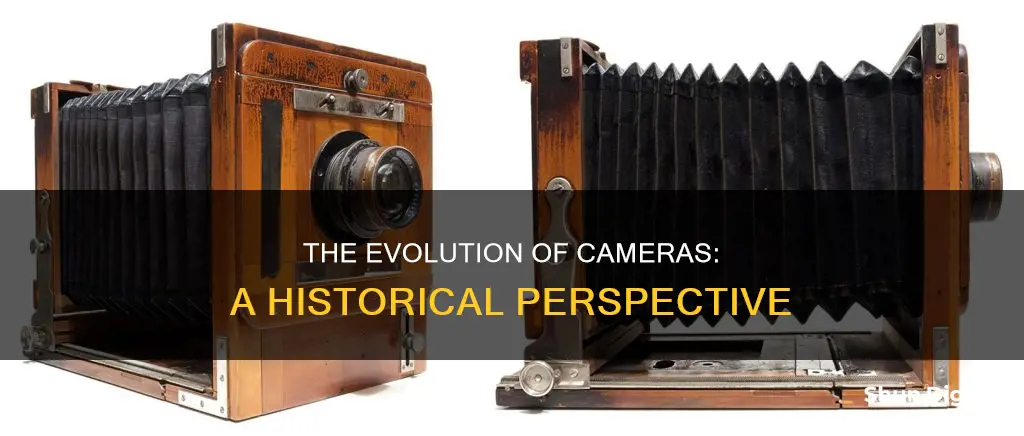
The history of the camera is a long and fascinating one, spanning centuries and involving numerous pioneers. The first device recognised as a camera was invented in 1816 by French inventor Nicephore Niepce. However, early prototypes of camera-like tools such as the pinhole camera and camera obscura existed long before. The camera obscura, meaning 'dark room' in Latin, is a natural optical phenomenon where an inverted image is projected through a small aperture. The earliest explanation of this comes from Han Chinese philosopher Mozi around 470 to 391 BC.
Niepce created the first permanent photograph in 1826 or 1827, using a camera obscura and a light-sensitive material called 'Bitumen of Judea' or 'Asphalt of Syria'. He called this process 'heliography', meaning 'sun drawing'. This image, taken from the window of his home in Le Gras, France, is now considered the world's first photograph.
Following Niepce's death in 1833, his colleague Louis Daguerre continued his work and produced the first portable camera in 1839, called the Daguerreotype. This camera used a plate coated with a thin film of silver iodide, exposed to light for several minutes or hours. Daguerre treated the image with mercury vapour and saltwater to remove the silver iodide, leaving behind a permanent image.
The Daguerreotype was extremely popular, and the French government presented the technology as a 'gift to the world'. However, it was an expensive process and could only create a single image. In the same year, Henry Fox Talbot unveiled a different type of camera, the Calotype, which produced negative images.
| Characteristics | Values |
|---|---|
| Date of invention | 1816 |
| Inventor | Joseph Nicéphore Niépce |
| Image type | Negative |
| Image material | Paper coated with silver chloride |
| Image permanence | No |
| Image quality | Blurred |
What You'll Learn

The first camera was invented in 1816 by Joseph Nicephore Niepce
Niepce's first experiments with photography began in 1816. He positioned paper sheets of silver salts, known to blacken with daylight, at the back of a camera obscura. In May 1816, he produced the first image of nature: a view from a window. However, the image vanished because, in broad daylight, the coated paper becomes completely black. He called these images "retinas".
Niepce sought to obtain positive images, so he turned to compounds that are bleached by light instead of blackened. He experimented with salts, iron oxide, and manganese black oxide, but stumbled upon the fixing problem. Niepce persevered, and by March 1817, he had found a way to fix the image. He discovered that Gaïacum resin loses its solubility in alcohol when exposed to daylight. He coated a pewter plate with the resin and placed it in a camera obscura. After several days of exposure to sunlight, the plate yielded an impression of the view outside.
Niepce called his process heliography, from the Greek helios, meaning 'drawing with the sun'. In 1826, he used this process to capture the earliest surviving photograph, a view from a window of his house in Chalons-sur-Saône, which required an exposure of about 8 hours. This image is now preserved as part of the Gernsheim Collection at the University of Texas.
Niepce's invention of the camera was the culmination of centuries of advancements in optics and chemistry. The camera obscura, or "dark room", is a natural optical phenomenon that projects an inverted image of a scene from the other side of a screen or wall through a small aperture. The earliest descriptions of the camera obscura date back to Chinese manuscripts from 400 BC and the works of Aristotle around 330 BC. The Arab physicist Ibn al-Haytham (c. 965-1040 AD) made significant contributions to the understanding of the camera obscura and is often credited with the invention of the pinhole camera.
Niepce's camera represented a significant advancement in the history of the camera, as it was the first device capable of capturing and recording an image. His invention paved the way for further developments in photography, leading to the creation of the first photographic camera by Louis Daguerre in 1839.
Transitioning from Camera Raw to Lightroom: A Guide
You may want to see also

The first photograph was taken in 1826 by Niepce
The first photograph was taken in 1826 by Joseph Nicéphore Niépce, a French inventor and one of the earliest pioneers of photography. Niépce developed heliography, a technique he used to create the world's oldest surviving products of a photographic process.
In the mid-1820s, Niépce used a primitive camera to produce the oldest surviving photograph of a real-world scene. The photograph was taken at Le Gras, France, Niépce's country estate near Chalon-sur-Saône. The image captured the view from the window of his upper-story workroom, including the upper loft (or "pigeon-house") of the family house, a pear tree, the slanting roof of the barn, and another wing of the family house.
Niépce's process involved coating a pewter plate with bitumen of Judea, a naturally occurring asphalt that artists used as an acid-resistant coating on copper plates for making etchings. After exposing the plate to light for eight hours, Niépce washed the plate with a mixture of oil of lavender and white petroleum, dissolving away the parts of the bitumen that had not hardened in the light. This revealed the latent image, creating a permanent direct positive picture.
The photograph is now housed at the University of Texas at Austin, where it was verified as authentic and acquired by the photohistorian Helmut Gernsheim in 1952.
Setting Up Your 7-Mode Camera: A Step-by-Step Guide
You may want to see also

The first camera obscura was used by Mozi in 400 BC
The first camera obscura was used by Mozi, a Chinese philosopher, in 400 BC. The camera obscura, which translates to "dark room" in Latin, is a natural optical phenomenon where an inverted image of a scene is projected from the other side of a screen or wall through a small aperture onto a surface opposite the opening.
Mozi was the first to document the principle of the camera obscura, correctly arguing that the image's inversion is caused by light travelling in straight lines from its source. This ancient device is the precursor of the photographic camera, and its evolution over centuries led to the modern cameras we use today.
The camera obscura was a dark room or box with a small hole or lens on one side that allowed light to enter and project an image on the opposite wall. This image would be upside down due to the nature of optics. Mozi observed that light from an illuminated object passing through a pinhole into a dark room created an inverted image of the original object.
Subsequent scholars and scientists, such as Aristotle, Anthemius of Tralles, Al-Kindi, and Alhazen (Ibn al-Haytham), further experimented with light passing through a small hole, contributing to the understanding of the camera obscura. In the 11th century, Alhazen is credited with inventing the camera obscura and the pinhole camera, conducting experiments with light in a darkened room and providing the first correct analysis of the phenomenon.
Over time, the camera obscura evolved, with improvements made by various scholars and inventors. In the 16th century, Italian scholar Giambattista della Porta added a concave lens to improve the image quality. The term "camera obscura" was first used by German astronomer Johannes Kepler in 1604, and he created a portable version for his travels. Artists in the 17th and 18th centuries, such as Vermeer and Canaletto, used these portable camera obscuras to aid their artwork.
The camera obscura played a crucial role in the development of photography, with Joseph Nicéphore Niépce using it to create what is believed to be the world's first photograph in 1816. Niépce continued his experiments, collaborating with Louis Daguerre from 1829 until his death in 1833. Daguerre went on to refine the process, introducing the daguerreotype in 1839, which produced detailed images with shorter exposure times and was more portable.
Switching Up S7 Camera Modes: A Guide
You may want to see also

The first photographic camera was developed in 1816
Niépce's first experiments with photography involved positioning paper coated with silver salts, known to blacken with daylight, at the back of a camera obscura. In May 1816, he produced the first image of nature: a view from a window. However, the image vanished because the coated paper becomes completely black when exposed to broad daylight.
Niépce continued to experiment with different compounds, seeking to obtain positive images. He tried using salts, iron oxide, and manganese black oxide, but encountered problems with fixing the image. Undeterred, Niépce continued his research, focusing on the effects of light on acids. He also investigated the use of resins, including the resin of Gaïacum and asphalt or bitumen of Judea, which became non-soluble when exposed to light.
In 1824, Niépce placed lithographic stones coated with bitumen at the back of a camera obscura and obtained the first fixed image of a landscape. This required an extremely long exposure time of several days in broad daylight. Niépce continued to refine his process, using copper and tin plates, and in 1827 he travelled to England to try to generate interest in his work.
In 1829, Niépce formed a partnership with Parisian painter Louis-Jacques-Mande Deguerre (also known as Louis Daguerre) to further refine the process and make it commercially viable. Unfortunately, Niépce died in 1833, but Daguerre continued their work and in 1839 he invented the daguerreotype, the first form of photography with practical exposure times.
Solar Power for Your Swann Cameras: A Guide
You may want to see also

The first mass-marketed camera was produced in 1839
The history of cameras is a long and fascinating one, with the first camera being invented in 1839. This camera was a daguerreotype camera produced by Alphonse Giroux, and it marked a pivotal moment in the history of photography.
The daguerreotype camera was the first mass-marketed camera, making photography accessible to a wider range of people. For the price of 400 francs, approximately $7,000 in today's money, anyone could purchase this camera and begin capturing their own images. The camera had an exposure time of 5 to 30 minutes, and users could buy standardised plates in various sizes to suit their needs.
The design of the daguerreotype camera was a significant improvement over the simple pinhole cameras of the past. It featured a double-box design, with a landscape lens on the outer box and an image plate holder on the inner box. The inner box could slide back and forth to adjust the focus, making it possible to capture sharp and clear images.
The daguerreotype camera played a crucial role in popularising photography and paved the way for future innovations in camera technology. It was a significant step forward from the experimental cameras of the past, and its accessibility meant that photography was no longer limited to a select few.
The daguerreotype camera also had a profound impact on the art world. With this camera, photographers were no longer restricted to capturing landscapes due to long exposure times. They could now photograph people, still life, and street views, opening up new possibilities for artistic expression.
The mass production and commercialisation of the daguerreotype camera by Alphonse Giroux marked a turning point in the history of photography. It empowered everyday people to capture and preserve memories, document important events, and express their creativity through the medium of photography.
Charging Olympus Camera Batteries: Where and How?
You may want to see also







